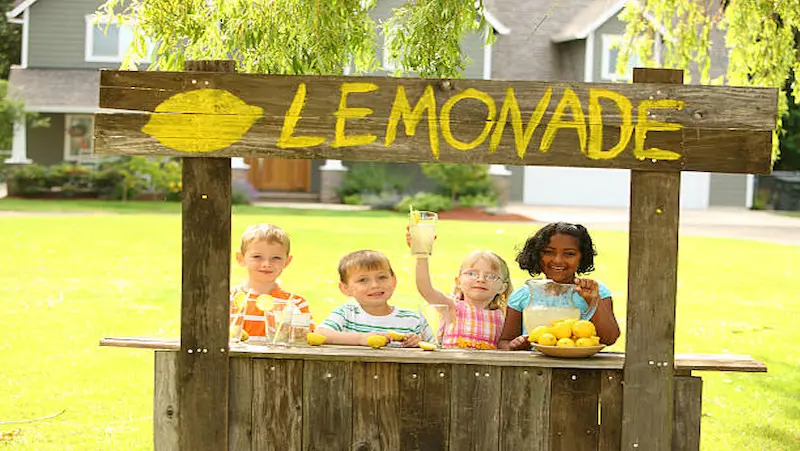In a world where financial landscapes are constantly evolving, imparting financial wisdom to our children has become more crucial than ever. The importance of financial education for the younger generation extends beyond the realm of managing allowances; it lays the foundation for a lifetime of informed decision-making, responsible budgeting, and a secure financial future. As we navigate an increasingly complex economic environment, empowering children with the knowledge and skills to navigate these waters becomes an investment in their resilience, independence, and overall well-being.
Table of contents
The Piggy Bank Adventure

In the corners of many childhood memories lies a timeless companion—the humble piggy bank. Its stout form, adorned with whimsical designs, has served as the starting point of many financial journeys. Let’s take a moment to revisit the classic concept of the piggy bank and the nostalgia it carries.
Picture this: a small child, wide-eyed and grinning, dropping a shiny coin into the slot atop a pig-shaped vessel. The satisfying clink as the coin finds its place becomes a symphony of childhood savings. The piggy bank isn’t just a receptacle for loose change; it’s a portal to financial responsibility and early lessons in thriftiness.
What makes the piggy bank an enduring symbol? Perhaps it’s the tactile joy of physically feeding it, the tangible representation of saving for a rainy day. As a child, breaking open the piggy bank is a momentous occasion, a rite of passage into the world of financial independence, albeit on a small scale.
The piggy bank adventure transcends generations, embodying the simplicity and charm of bygone days. In a world increasingly dominated by digital transactions, the physicality of a piggy bank stands as a quaint reminder of a time when the clatter of coins was music to our ears.
In its simplicity, the piggy bank becomes a teacher, instilling values that echo into adulthood. Saving a portion of pocket money, watching the coins accumulate, and eventually cashing in for a coveted toy—the journey encapsulates the essence of responsible money management.
Money-Related Board Games
In a world dominated by screens and virtual experiences, there’s something nostalgic and satisfying about gathering around a table for a good old-fashioned board game night. But what if we told you that your next game night could be not only entertaining but also educational in the realm of finance? Enter the exciting universe of money-related board games – where laughter meets learning and strategy intertwines with financial games for students savvy.

Monopoly: Beyond Park Place and Boardwalk
Monopoly, a classic among classics, has been a staple in households for generations. Beyond the joy of acquiring prime real estate like Park Place and Boardwalk, this game is a crash course in financial maneuvering. It teaches negotiation skills, the art of property investment, and the importance of risk-taking. Watch out for those Community Chest cards – life, much like the game, can be unpredictable.
The Game of Life: Navigate Life’s Twists and Turns
Life is a journey filled with twists, turns, and financial surprises. The Game of Life mirrors this reality in a whimsical way. From choosing a career path to navigating unexpected expenses, players face decisions that mimic real-life choices. This game is more than just a roll of the dice; it’s a lesson in budgeting, planning for the future, and adapting to the unpredictable nature of life.
Cashflow: Investing 101 at Your Fingertips
For those looking to level up their financial IQ, Cashflow, designed by Robert Kiyosaki, takes the concept of a board game to a whole new level. This game is essentially a financial simulator that introduces players to the world of investing, assets, and liabilities. It’s a crash course in wealth-building where the goal is not just to survive but to thrive financially. Consider it an MBA in a box, without the hefty tuition fees.
Real-Life Grocery Shopping Simulation
In the hustle and bustle of our daily lives, few activities for financial literacy mirror the complexity of decision-making quite like a trip to the grocery store. Beyond the fluorescent-lit aisles and neatly stacked shelves lies a real-life simulation that teaches us valuable skills – budgeting, planning, and decision-making.

Budgeting on Aisle 5:
Walking into a grocery store armed with a shopping list and a fixed budget is akin to entering a financial battlefield. The experience forces us to evaluate needs versus wants, making us mindful of every penny we spend. It’s a crash course in financial responsibility that no textbook can replicate. As we scrutinize prices, compare brands, and make choices based on our budget constraints, we’re essentially engaging in an everyday exercise in money management.
Planning, Not Just for the Checkout Line:
The grocery store is a puzzle, and our shopping list is the roadmap. Planning ahead ensures we don’t succumb to the tantalizing allure of impulse purchases. Just like planning a project at work, strategizing our route through the store and ticking items off our list is a lessons plan on money in foresight. It’s about creating order out of chaos, one item at a time.
Decision-Making in the Produce Section:
Every fruit and vegetable displays its own tempting array of choices. The decision to go organic, local, or opt for budget-friendly alternatives is a microcosm of life’s myriad choices. Should you choose the pre-cut pineapple for convenience, or does the frugal side of you insist on wrestling with a whole one at home? The grocery store compels us to confront decisions head-on, honing our ability to make choices that align with our priorities.
The Entrepreneurial Lemonade Stand
In a world buzzing with technology and screens, there’s something refreshingly simple about the classic lemonade stand. It’s more than just a summer pastime; it’s a hands-on lesson in entrepreneurship that can shape young minds. As parents and educators, we have the unique opportunity to cultivate a spirit of innovation and business acumen in our kids through this timeless venture.

Choosing the Right Time and Place:
Timing is key, so pick a sunny day when the neighborhood is abuzz with activity. Select a high-traffic location—perhaps near a park, community event, or a popular local spot. This not only ensures a steady stream of customers but also exposes kids to the dynamics of demand and supply.
Setting the Stage:
Encourage creativity in designing the lemonade stand. Let kids take charge of decorating signs, creating a catchy name, and arranging the setup. This not only boosts their artistic skills but also instills a sense of ownership in the project.
Ingredients for Success:
Teach kids the basics of budgeting and purchasing. Involve them in shopping for lemons, sugar, and other ingredients, explaining the concept of expenses and profits. This practical experience lays the foundation for financial literacy projects in a fun and engaging way.
Pricing and Salesmanship:
Guide youngsters in setting reasonable prices for their lemonade. Discuss the importance of customer service and the art of persuasion. Interacting with customers not only hones their social skills but also provides firsthand insights into consumer preferences.
Counting the Profits:
Once the lemonade stand adventure concludes, gather the kids for a ‘business meeting.’ Count the earnings, subtract the expenses, and calculate the profit. This real-world math lesson reinforces the connection between effort, investment, and financial returns.
Reflecting on the Experience:
Encourage kids to reflect on the entire process. What worked well? What could be improved? These discussions foster critical thinking and resilience, valuable traits for any aspiring entrepreneur.
Celebrating Achievements:
Regardless of the monetary outcome, celebrate the journey. Acknowledge the hard work, creativity, and courage it took to set up and run the lemonade stand. Positive reinforcement boosts confidence and motivates kids to embrace challenges in the future.
Storytelling with Money
In the vast realm of personal finance, storytelling emerges as a powerful tool to impart wisdom and foster a deeper understanding of the nuances of money. From childhood to adulthood, the journey of financial literacy is often paved with tales of success, failure, and valuable lessons. Here’s a curated list of books that cater to various age groups, blending storytelling with the art of money management.

For the Young Dreamers (Ages 5-10):
“Bunny Money” by Rosemary Wells
This delightful children’s book follows Max and Ruby on a shopping adventure, teaching basic financial concepts in a charming and relatable way. It’s a fantastic introduction to the world of spending and saving for our youngest readers.
Navigating Adolescence (Ages 11-15):
“Lemonade War” by Jacqueline Davies
This middle-grade novel explores the entrepreneurial spirit of two siblings who embark on a lemonade stand competition. It’s a great read for tweens, introducing them to fundamental business concepts and the value of hard work.
Teenagers and Beyond (Ages 16-21):
“Rich Dad Poor Dad” by Robert Kiyosaki
A classic in financial literature, this book challenges conventional thinking about money. Written in a conversational style, it encourages young adults to think differently about assets, liabilities, and the path to financial independence.
Entering the Workforce (Ages 22-30):
“The Millionaire Next Door” by Thomas J. Stanley and William D. Danko
This book is a compelling exploration of the habits and lifestyles of everyday millionaires. Geared toward those entering the workforce, it sheds light on the importance of frugality, savings, and long-term financial planning.
Building a Legacy (Ages 30 and Beyond):
“The Richest Man in Babylon” by George S. Clason
Set in ancient Babylon, this timeless classic imparts financial wisdom through parables and stories. It’s a must-read for adults, emphasizing the principles of saving, investing, and creating a lasting legacy for future generations.
Digital Learning Apps and Games
In the ever-evolving landscape of education, digital learning apps and games have become indispensable tools for shaping young minds. When it comes to imparting crucial life skills like financial literacy, developers have risen to the challenge, creating engaging platforms that make learning about money fun for kids. Here’s a curated list of age-appropriate apps that seamlessly blend education with entertainment to instill financial concepts early on.

PiggyBot (Ages 6-8):
Introduce your little ones to the world of budgeting with PiggyBot. This interactive app uses a virtual piggy bank to teach kids the importance of saving, spending, and sharing money. With a user-friendly interface and colorful graphics, it makes financial planning a breeze for young minds.
iAllowance (Ages 9-12):
As kids enter the pre-teen years, iAllowance steps in to teach more advanced financial concepts. This app allows parents to set up virtual allowances, automate payments, and even incentivize chores. It’s a hands-on approach to money management that fosters responsibility.
Bankaroo (Ages 10-14):
Bankaroo serves as a virtual bank for kids, providing a safe space to learn about budgeting and financial responsibility. With features like tracking expenses, setting financial goals, and even dealing with loans, Bankaroo prepares tweens for the complexities of managing money.
Stockpile (Ages 12 and up):
For teenagers curious about the stock market, Stockpile is an excellent introduction. The app allows users to buy fractional shares of real stocks, teaching them about investing and the dynamics of the market in a simplified and accessible way.
Cashflow for Kids (Ages 14 and up):
Created by renowned financial educator Robert Kiyosaki, Cashflow for Kids is an extension of the Cashflow board game. Geared towards older teens, it provides a virtual platform to learn about investing, assets, and liabilities, laying the foundation for a solid financial future.
Money-Related Art and Crafts

Crafting Play Money:
Remember the days of playing “store” or “bank” with paper bills and coins? Relive that imaginative experience with a DIY play money project. Gather materials like colored paper, scissors, and markers. Cut out various denominations of bills and coins, allowing your creativity to shine as you design them with unique patterns or illustrations.
For an extra touch, involve the kids and turn it into a family affair. Assign each family member a role, from the chief designer to the quality control expert. Not only does this project spark creativity, but it also provides an opportunity to teach kids about currency denominations and the value of money in a fun and interactive way.
Personalized Savings Jars:
Transforming ordinary jars into personalized savings banks adds a touch of charm to financial management. Start by collecting empty jars of various shapes and sizes. Next, unleash your artistic flair with paints, stickers, or even decoupage to give each jar its own distinct personality.
Label each jar according to its purpose—whether it’s for a vacation fund, a rainy-day fund, or that special something you’ve been dreaming of. Not only does this make saving more enjoyable, but it also adds a visual reminder of your financial goals. Encourage family members or roommates to join in, creating a collection of unique savings jars that reflect individual aspirations.
The Benefits Beyond Art:
Engaging in money-related arts and crafts goes beyond the joy of creation. It instills financial literacy in a playful manner, especially for the younger members of the family. As you craft play money or decorate savings jars together, take the opportunity to discuss the importance of budgeting, saving, and setting financial goals.
Conclusion
In conclusion, transforming financial education into an enjoyable experience for kids is more than just a matter of fun; it’s a strategic investment in their future. By infusing joy into learning about money, we not only capture their attention but also instill lifelong habits that empower them to navigate the complex world of finances with confidence. In essence, making financial education enjoyable becomes a catalyst for fostering a generation of financially savvy individuals poised for success and stability.
To get your hands on more such articles, educational content, and free resources on coding for kids, robotics courses, game development, etc., check out the BrightCHAMPS Blog Page now!
Frequently Asked Questions
A1: Early financial education helps instill lifelong money management skills, fostering responsible habits and informed decision-making.
A2: Try a “Money Jar” activity where kids allocate play money to different jars representing spending categories, teaching them about budgeting in a fun way.
A3: The activities are designed with age-appropriate complexity, ensuring engagement and comprehension for various developmental stages.
A4: They integrate learning through play, incorporating interactive elements that make grasping financial concepts both entertaining and educational.
A5: Yes, the activities are adaptable, with varying levels of complexity, ensuring suitability for toddlers through pre-teens.
A6: Consider activities like a “Savings Challenge” where kids set goals, save allowances, and celebrate achievements, instilling a sense of accomplishment and the importance of saving.


 We are an army of educators and passionate learners from BrightChamps family, committed to providing free learning resources to kids, parents & students.
We are an army of educators and passionate learners from BrightChamps family, committed to providing free learning resources to kids, parents & students.












